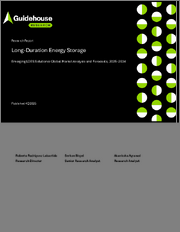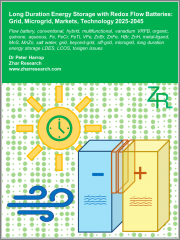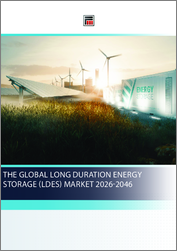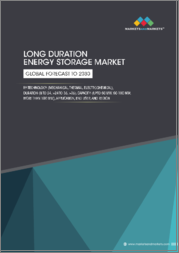
|
시장보고서
상품코드
1716374
세계의 장기 에너지 저장 시장 : 시장 예측 - 유형별, 저장 기간별, 용도별, 최종 사용자별, 지역별 분석(-2032년)Long Duration Energy Storage Market Forecasts to 2032 - Global Analysis By Type, Storage Duration, Application, End User and By Geography |
||||||
Stratistics MRC에 따르면 세계의 장기 에너지 저장(LDES) 시장은 2025년에 55억 달러로 추정되고, 예측 기간 동안 CAGR 14.6%로 성장할 전망이며, 2032년에는 142억 달러에 이를 전망입니다.
장기 에너지 저장(LDES)이란 몇 시간에서 며칠, 혹은 몇 주간의 장기간에 걸쳐 전력을 저장 및 방전하도록 설계된 에너지 저장 시스템을 말합니다. 이러한 시스템은 발전량이 적은 기간 동안 신뢰할 수 있는 백업을 제공함으로써 태양광이나 풍력과 같은 재생 에너지 발전의 간헐적인 균형을 맞추는 데 도움이 됩니다. 고도의 배터리, 양수발전, 열저장 등의 LDES 기술은 송전망의 안정성을 지원하고 안정적인 전력 공급을 확보할 수 있습니다. 이들은 에너지의 회복력을 높이고 화석 연료에 대한 의존을 줄이며 지속 가능한 저탄소 에너지의 미래를 실현하기 위해 필수적입니다.
태양에너지산업 협회(SEIA)에 따르면 미국의 2023년 태양에너지 도입량은 3,240만 kW로 2022년부터 51% 증가했습니다.
신재생 에너지 통합
신재생 에너지 시장 통합은 전력망을 안정시키고 에너지의 신뢰성을 높이는데 중요한 역할을 하고 있습니다. 태양광과 풍력 등 신재생 에너지원에서 발전된 잉여 에너지를 저장함으로써 LDES 시스템은 간헐적인 발전에 대한 지속 가능한 솔루션을 제공합니다. 이 통합은 수요와 공급의 균형을 맞추고 재생 에너지 출력이 낮은 기간에도 안정적인 전력 공급을 확보하는 데 도움이 됩니다. 청정 에너지에 대한 수요가 높아지는 가운데 LDES 기술은 저탄소로 재생 가능한 전력에 의한 미래로의 원활한 이행을 가능하게 합니다.
다른 에너지 저장 솔루션과의 경쟁
리튬 이온 배터리 및 양수 발전과 같은 다른 에너지 저장 솔루션과의 경쟁은 시장 성장을 방해할 수 있습니다. 이러한 대체 기술은 종종 초기 비용이 저렴하고 전개가 빠르기 때문에 저장 용량이 길지만 LDES 솔루션의 그늘에 가려질 수 있습니다. 그 결과, LDES는 투자와 시장 점유율을 확보하는데 있어 과제에 직면하여 장기간의 에너지 저장 요구에 대응할 가능성이 제한되어 보다 지속 가능하고 신뢰성이 높은 에너지 시스템으로의 전환이 지연될 수 있습니다.
에너지의 독립성 및 안전성
안정적이고 지속 가능한 에너지의 미래를 창출하기 위해서는 시장에서 에너지의 독립성과 안전성이 필수적입니다. 신재생 에너지 발전 기술은 신재생 에너지를 장기간 저장하여 발전량이 저하된 경우에도 안정된 전력공급을 보장합니다. 이를 통해 화석 연료에 대한 의존성을 줄이고 송전망의 신뢰성을 높일 수 있습니다. 보다 깨끗한 에너지에 대한 수요가 높아지는 가운데, LDES는 에너지 공급을 확보하고, 혼란을 완화하고, 보다 강인하고 자급자족적인 에너지 시스템으로의 전환을 지원하는데 중요한 역할을 하고 있습니다.
규제 및 정책의 불확실성
규제 및 정책의 불확실성은 시장 성장을 크게 방해할 수 있습니다. 일관성이 없거나 불분명한 규제는 투자 위험을 야기하고 기업이 LDES 프로젝트에 자원을 투입하는 의욕을 꺽습니다. 인센티브 및 보조금과 같은 명확한 정책 지원이 없으면 LDES 기술은 기존 솔루션과의 경쟁에 어려움을 겪을 수 있습니다. 이러한 불확실성은 기술 혁신을 늦추고 LDES의 보급을 늦추고 결국 더 강인하고 지속 가능한 에너지 인프라로의 전환을 방해합니다.
COVID-19의 영향
COVID-19의 유행은 시장에 파괴적인 영향을 미쳤습니다. 공급망 중단, 노동력 부족, 제조 및 설치 지연으로 인해 LDES 기술 개발이 지연되었습니다. 게다가 팬데믹 기간 중 신재생 에너지 프로젝트에 대한 투자 감소와 우선 사항 전환도 시장 성장을 방해했습니다. 그러나 팬데믹은 또한 레지리언트 에너지 시스템의 필요성을 부각시켰고, 팬데믹 이후 장기적인 에너지 안보와 지속 가능성을 확보하는 주요 요소로서 LDES 솔루션에 대한 새로운 관심을 불러일으켰습니다.
예측 기간 동안 플라이휠 에너지 저장 분야가 최대화될 전망
플라이휠 에너지 저장 분야는 예측 기간 동안 가장 큰 시장 점유율을 차지할 것으로 예측됩니다. 회전 운동 에너지의 형태로 에너지를 저장함으로써 플라이휠은 신속한 응답 시간과 긴 사이클 수명을 제공합니다. 플라이휠은 간헐적인 재생 에너지원의 균형을 맞추고 장기간에 걸쳐 송전망을 안정시키는데 적합합니다. 유지보수가 최소화되고 효율이 높은 플라이휠 시스템은 에너지 안보에 기여하고 화석연료에 대한 의존을 줄이며 지속 가능하고 강인한 에너지 그리드로의 이행을 지원할 수 있습니다.
예측 기간 동안 주택 부문의 CAGR이 가장 높을 것으로 예상
예측 기간 동안 주택 부문이 가장 높은 성장률을 나타낼 것으로 예측됩니다. 첨단 배터리나 플라이휠 등 LDES 기술을 통해 주택 소유자는 잉여 재생 에너지를 저장해 발전량 저하나 정전 시 사용할 수 있습니다. 이러한 솔루션은 축전 기간을 연장하고 송전망의 회복력을 높여 화석 연료에 대한 의존도를 낮춥니다. 지속가능한 에너지 솔루션에 대한 수요가 높아짐에 따라 주택용 LDES는 자급자족하고 에너지 효율이 높은 주택을 만드는 데 중요한 역할을 할 것으로 보입니다.
최대 점유율을 차지하는 지역 :
예측 기간 동안 아시아태평양은 신재생 에너지 수요 증가로 최대 시장 점유율을 차지할 것으로 예측됩니다. 중국, 일본, 인도 등의 국가들은 청정에너지의 이행을 지원하기 위해 LDES 기술에 많은 투자를 하고 있습니다. 풍부한 재생 가능 자원과 신뢰성 높은 에너지 저장의 필요성에 의해 선진 배터리나 양수 발전 등의 LDES 솔루션은 이 지역에서의 간헐적인 발전 극복, 그리드 회복력 향상, 지속 가능성 목표 달성의 열쇠가 됩니다.
CAGR이 가장 높은 지역 :
예측 기간 동안 북미가 가장 높은 CAGR을 나타낼 것으로 예측됩니다. 배터리, 플로우 배터리, 열저장 시스템 등의 에너지 저장 기술과 관련된 비용 절감으로 LDES는 보다 재정적으로 실행 가능합니다. 또한 북미에서는 연방정부 차원에서도 주정부 차원에서도 보조금, 조성금, 세제 혜택을 통해 에너지 저장을 지원하는 움직임이 강해지고 있습니다. 예를 들어, 미국의 인플레이션 삭감법에는 에너지 저장 기술을 지원하는 조항이 포함되어 있어 LDES 개발에 이익을 가져다 주고 있습니다.
무료 주문을 받아서 만드는 서비스 :
이 보고서를 구독하는 고객은 다음 무료 맞춤설정 옵션 중 하나를 사용할 수 있습니다.
- 기업 프로파일
- 추가 시장 기업의 종합적 프로파일링(3개사까지)
- 주요 기업의 SWOT 분석(3개사까지)
- 지역 세분화
- 고객의 관심에 응한 주요국 시장 추계, 예측 및 CAGR(주 : 타당성 확인에 따름)
- 경쟁 벤치마킹
- 제품 포트폴리오, 지리적 존재, 전략적 제휴에 기반한 주요 기업 벤치마킹
목차
제1장 주요 요약
제2장 서문
- 개요
- 이해관계자
- 조사 범위
- 조사 방법
- 데이터 마이닝
- 데이터 분석
- 데이터 검증
- 조사 접근
- 조사 자료
- 1차 조사 자료
- 2차 조사 정보원
- 전제조건
제3장 시장 동향 분석
- 성장 촉진요인
- 성장 억제요인
- 기회
- 위협
- 용도 분석
- 최종 사용자 분석
- 신흥 시장
- COVID-19의 영향
제4장 Porter's Five Forces 분석
- 공급기업의 협상력
- 구매자의 협상력
- 대체품의 위협
- 신규 참가업체의 위협
- 경쟁 기업간 경쟁 관계
제5장 세계의 장기 에너지 저장 시장 : 유형별
- 양수 발전(PHS)
- 압축공기 에너지 저장(CAES)
- 플로우 배터리
- 플라이휠 에너지 저장
- 열에너지 저장(TES)
- 기타 유형
제6장 세계의 장기 에너지 저장 시장 : 저장 기간별
- 단시간(최대 4시간)
- 중간 정도의 지속시간(4-12시간)
- 장시간(12시간 이상)
제7장 세계의 장기 에너지 저장 시장 : 용도별
- 그리드 에너지 저장
- 신재생 에너지 통합
- 피크 면도
- 주파수 조정
- 백업 전원
- 오프 그리드 전력 시스템
- 기타 용도
제8장 세계의 장기 에너지 저장 시장 : 최종 사용자별
- 유틸리티
- 상업 및 산업(C&I)
- 주택
- 운송
- 통신 및 데이터센터
- 기타 최종 사용자
제9장 세계의 장기 에너지 저장 시장 : 지역별
- 북미
- 미국
- 캐나다
- 멕시코
- 유럽
- 독일
- 영국
- 이탈리아
- 프랑스
- 스페인
- 기타 유럽
- 아시아태평양
- 일본
- 중국
- 인도
- 호주
- 뉴질랜드
- 한국
- 기타 아시아태평양
- 남미
- 아르헨티나
- 브라질
- 칠레
- 기타 남미
- 중동 및 아프리카
- 사우디아라비아
- 아랍에미리트(UAE)
- 카타르
- 남아프리카
- 기타 중동 및 아프리카
제10장 주요 발전
- 계약, 파트너십, 협업 및 합작투자
- 인수 및 합병
- 신제품 발매
- 사업 확대
- 기타 주요 전략
제11장 기업 프로파일링
- Alsym Energy Inc.
- Ambri Incorporated.
- CMBlu Energy AG.
- Energy Vault, Inc.
- Eos Energy Enterprises
- ESS Tech, Inc.
- Form Energy
- GKN Hydrogen
- Highview Power
- Invinity Energy Systems
- QuantumScape Battery, Inc.
- RheEnergise Limited.
- SFW.
- Sumitomo Electric Industries, Ltd.
- VFlowTech Pte Ltd.
- VoltStorage
According to Stratistics MRC, the Global Long Duration Energy Storage Market is accounted for $5.5 billion in 2025 and is expected to reach $14.2 billion by 2032 growing at a CAGR of 14.6% during the forecast period. Long Duration Energy Storage (LDES) describes energy storage systems designed to store and discharge electricity over extended periods, ranging from several hours to days or even weeks. These systems help balance intermittent renewable energy sources like solar and wind by providing a reliable backup during periods of low generation. LDES technologies, such as advanced batteries, pumped hydro, or thermal storage, can support grid stability and ensure a steady power supply. They are critical for enhancing energy resilience, reducing reliance on fossil fuels, and enabling a sustainable, low-carbon energy future.
According to the Solar Energy Industries Association (SEIA), the U.S. installed 32.4 GW of solar energy in 2023, a 51% increase from 2022.
Market Dynamics:
Driver:
Integration of Renewable Energy
The integration of renewable energy into the market plays a crucial role in stabilizing power grids and enhancing energy reliability. By storing excess energy generated from renewable sources like solar and wind, LDES systems provide a sustainable solution for intermittent generation. This integration helps balance supply and demand, ensuring consistent power availability during periods of low renewable output. As the demand for clean energy increases, LDES technologies enable a seamless transition to a low-carbon, renewable-powered future.
Restraint:
Competition from other energy storage solutions
Competition from other energy storage solutions, such as lithium-ion batteries or pumped hydro storage, can hinder the growth of the market. These alternative technologies, often with lower upfront costs and faster deployment, may overshadow LDES solutions despite their longer storage capabilities. As a result, LDES might face challenges in securing investment and market share, limiting its potential to address energy storage needs for extended periods and delaying the transition to more sustainable, reliable energy systems.
Opportunity:
Energy Independence and security
Energy independence and security in the market are vital for creating a stable and sustainable energy future. LDES technologies store renewable energy for extended periods, ensuring a consistent power supply even when generation is low. This reduces dependence on fossil fuels and enhances grid reliability. As demand for cleaner energy grows, LDES plays a critical role in securing energy supply, mitigating disruptions, and supporting the transition to a more resilient and self-sufficient energy system.
Threat:
Regulatory and policy uncertainty
Regulatory and policy uncertainty can significantly impede the growth of the market. Inconsistent or unclear regulations can create investment risks, discouraging companies from committing resources to LDES projects. Without clear policy support, such as incentives or subsidies, LDES technologies may struggle to compete with established solutions. This uncertainty can also slow down innovation and delay the widespread adoption of LDES, ultimately hindering the transition to a more resilient, sustainable energy infrastructure.
Covid-19 Impact
The COVID-19 pandemic had a disruptive impact on the market. Supply chain interruptions, labor shortages, and delays in manufacturing and installation slowed the development of LDES technologies. Additionally, reduced investment in renewable energy projects and shifting priorities during the pandemic hindered market growth. However, the pandemic also highlighted the need for resilient energy systems, sparking renewed interest in LDES solutions as a key element in ensuring long-term energy security and sustainability post-pandemic.
The flywheel energy storage segment is expected to be the largest during the forecast period
The flywheel energy storage segment is expected to account for the largest market share during the forecast period. By storing energy in the form of rotational kinetic energy, flywheels offer rapid response times and long cycle lives. They are well-suited for balancing intermittent renewable energy sources and providing grid stability over extended periods. With minimal maintenance and high efficiency, flywheel systems can contribute to energy security, reduce dependence on fossil fuels, and support the transition to a sustainable, resilient energy grid.
The residential segment is expected to have the highest CAGR during the forecast period
Over the forecast period, the residential segment is predicted to witness the highest growth rate. LDES technologies, such as advanced batteries and flywheels, enable homeowners to store excess renewable energy for use during periods of low generation or power outages. These solutions offer extended storage durations, improving grid resilience and reducing reliance on fossil fuels. As demand for sustainable energy solutions grows, residential LDES will play a crucial role in creating self-sufficient, energy-efficient homes.
Region with largest share:
During the forecast period, the Asia Pacific region is expected to hold the largest market share driven by increasing demand for renewable energy. Countries like China, Japan, and India are investing heavily in LDES technologies to support their clean energy transitions. With abundant renewable resources and the need for reliable energy storage, LDES solutions such as advanced batteries and pumped hydro are key to overcoming intermittent power generation, improving grid resilience, and achieving sustainability goals in the region.
Region with highest CAGR:
Over the forecast period, the North America region is anticipated to exhibit the highest CAGR. The reduction in costs associated with energy storage technologies, including batteries, flow batteries, and thermal storage systems, has made LDES more financially viable. Additionally, Governments at both federal and state levels in North America are increasingly supporting energy storage through subsidies, grants, and tax incentives. For instance, the U.S. Inflation Reduction Act includes provisions for supporting energy storage technologies, which benefits LDES development.
Key players in the market
Some of the key players profiled in the Long Duration Energy Storage Market include Alsym Energy Inc., Ambri Incorporated., CMBlu Energy AG., Energy Vault, Inc., Eos Energy Enterprises, ESS Tech, Inc., Form Energy, GKN Hydrogen, Highview Power, Invinity Energy Systems, QuantumScape Battery, Inc., RheEnergise Limited., SFW., Sumitomo Electric Industries, Ltd., VFlowTech Pte Ltd. and VoltStorage.
Key Developments:
In February 2025, Sumitomo Electric Industries Ltd (TYO:5802) has launched a project to install a 4-MW/12.5-MWh redox flow battery system in Ama Town, in Japan's Oki Islands.The project is a joint effort between Chugoku Electric Power Transmission & Distribution Co Inc, Ama Town, and como-gomo.company, supported by a subsidy from Japan's ministry of the environment.
In January 2024, Sumitomo Electric Industries, Ltd. announced that its redox flow battery (hereinafter "RF battery") has been selected as a grid-scale battery for a power system stabilization project by SHIN-IDEMITSU Co., Ltd. (Headquarters: Hakata-ku, Fukuoka; President and Group CEO: Yasunori Idemitsu; hereinafter "IDEX"). Construction for this project has now commenced in Kumamoto.
Types Covered:
- Pumped Hydro Storage (PHS)
- Compressed Air Energy Storage (CAES)
- Flow Batteries
- Flywheel Energy Storage
- Thermal Energy Storage (TES)
- Other Types
Storage Duration Covered:
- Short Duration (up to 4 hours)
- Medium Duration (4-12 hours)
- Long Duration (12+ hours)
Applications Covered:
- Grid Energy Storage
- Renewable Energy Integration
- Peak Shaving
- Frequency Regulation
- Backup Power Supply
- Off-Grid Power Systems
- Other Applications
End Users Covered:
- Utilities
- Commercial & Industrial (C&I)
- Residential
- Transportation
- Telecommunications and Data Centers
- Other End Users
Regions Covered:
- North America
- US
- Canada
- Mexico
- Europe
- Germany
- UK
- Italy
- France
- Spain
- Rest of Europe
- Asia Pacific
- Japan
- China
- India
- Australia
- New Zealand
- South Korea
- Rest of Asia Pacific
- South America
- Argentina
- Brazil
- Chile
- Rest of South America
- Middle East & Africa
- Saudi Arabia
- UAE
- Qatar
- South Africa
- Rest of Middle East & Africa
What our report offers:
- Market share assessments for the regional and country-level segments
- Strategic recommendations for the new entrants
- Covers Market data for the years 2024, 2025, 2026, 2028, and 2032
- Market Trends (Drivers, Constraints, Opportunities, Threats, Challenges, Investment Opportunities, and recommendations)
- Strategic recommendations in key business segments based on the market estimations
- Competitive landscaping mapping the key common trends
- Company profiling with detailed strategies, financials, and recent developments
- Supply chain trends mapping the latest technological advancements
Free Customization Offerings:
All the customers of this report will be entitled to receive one of the following free customization options:
- Company Profiling
- Comprehensive profiling of additional market players (up to 3)
- SWOT Analysis of key players (up to 3)
- Regional Segmentation
- Market estimations, Forecasts and CAGR of any prominent country as per the client's interest (Note: Depends on feasibility check)
- Competitive Benchmarking
- Benchmarking of key players based on product portfolio, geographical presence, and strategic alliances
Table of Contents
1 Executive Summary
2 Preface
- 2.1 Abstract
- 2.2 Stake Holders
- 2.3 Research Scope
- 2.4 Research Methodology
- 2.4.1 Data Mining
- 2.4.2 Data Analysis
- 2.4.3 Data Validation
- 2.4.4 Research Approach
- 2.5 Research Sources
- 2.5.1 Primary Research Sources
- 2.5.2 Secondary Research Sources
- 2.5.3 Assumptions
3 Market Trend Analysis
- 3.1 Introduction
- 3.2 Drivers
- 3.3 Restraints
- 3.4 Opportunities
- 3.5 Threats
- 3.6 Application Analysis
- 3.7 End User Analysis
- 3.8 Emerging Markets
- 3.9 Impact of Covid-19
4 Porters Five Force Analysis
- 4.1 Bargaining power of suppliers
- 4.2 Bargaining power of buyers
- 4.3 Threat of substitutes
- 4.4 Threat of new entrants
- 4.5 Competitive rivalry
5 Global Long Duration Energy Storage Market, By Type
- 5.1 Introduction
- 5.2 Pumped Hydro Storage (PHS)
- 5.3 Compressed Air Energy Storage (CAES)
- 5.4 Flow Batteries
- 5.5 Flywheel Energy Storage
- 5.6 Thermal Energy Storage (TES)
- 5.7 Other Types
6 Global Long Duration Energy Storage Market, By Storage Duration
- 6.1 Introduction
- 6.2 Short Duration (up to 4 hours)
- 6.3 Medium Duration (4-12 hours)
- 6.4 Long Duration (12+ hours)
7 Global Long Duration Energy Storage Market, By Application
- 7.1 Introduction
- 7.2 Grid Energy Storage
- 7.3 Renewable Energy Integration
- 7.4 Peak Shaving
- 7.5 Frequency Regulation
- 7.6 Backup Power Supply
- 7.7 Off-Grid Power Systems
- 7.8 Other Applications
8 Global Long Duration Energy Storage Market, By End User
- 8.1 Introduction
- 8.2 Utilities
- 8.3 Commercial & Industrial (C&I)
- 8.4 Residential
- 8.5 Transportation
- 8.6 Telecommunications and Data Centers
- 8.7 Other End Users
9 Global Long Duration Energy Storage Market, By Geography
- 9.1 Introduction
- 9.2 North America
- 9.2.1 US
- 9.2.2 Canada
- 9.2.3 Mexico
- 9.3 Europe
- 9.3.1 Germany
- 9.3.2 UK
- 9.3.3 Italy
- 9.3.4 France
- 9.3.5 Spain
- 9.3.6 Rest of Europe
- 9.4 Asia Pacific
- 9.4.1 Japan
- 9.4.2 China
- 9.4.3 India
- 9.4.4 Australia
- 9.4.5 New Zealand
- 9.4.6 South Korea
- 9.4.7 Rest of Asia Pacific
- 9.5 South America
- 9.5.1 Argentina
- 9.5.2 Brazil
- 9.5.3 Chile
- 9.5.4 Rest of South America
- 9.6 Middle East & Africa
- 9.6.1 Saudi Arabia
- 9.6.2 UAE
- 9.6.3 Qatar
- 9.6.4 South Africa
- 9.6.5 Rest of Middle East & Africa
10 Key Developments
- 10.1 Agreements, Partnerships, Collaborations and Joint Ventures
- 10.2 Acquisitions & Mergers
- 10.3 New Product Launch
- 10.4 Expansions
- 10.5 Other Key Strategies
11 Company Profiling
- 11.1 Alsym Energy Inc.
- 11.2 Ambri Incorporated.
- 11.3 CMBlu Energy AG.
- 11.4 Energy Vault, Inc.
- 11.5 Eos Energy Enterprises
- 11.6 ESS Tech, Inc.
- 11.7 Form Energy
- 11.8 GKN Hydrogen
- 11.9 Highview Power
- 11.10 Invinity Energy Systems
- 11.11 QuantumScape Battery, Inc.
- 11.12 RheEnergise Limited.
- 11.13 SFW.
- 11.14 Sumitomo Electric Industries, Ltd.
- 11.15 VFlowTech Pte Ltd.
- 11.16 VoltStorage

















